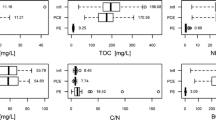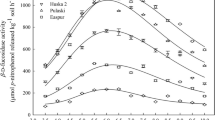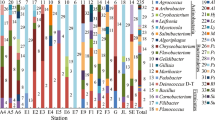Summary
A simple, precise, and sensitive method to assay l-asparaginase (l-asparagine amidohydrolase, EC 3.5.1.1) activity in soils is described. This method use steam distillation to determine the NH sup+inf4 produced by l-asparaginase activity when soil is incubated with buffered (0.1 M THAM, pH 10) l-asparagine solution and toluene at 30°C for 2 h. The procedure developed gives quantitative recovery of NH sup+inf4 -N added to soils and does not cause chemical hydrolysis of l-asparagine. The optimum buffer pH for NH sup+inf4 -N released by l-asparaginase activity in soils was 10. This enzyme was saturated with 50 mM l-asparagine, and the reaction rate essentially followed zero-order kinetics. The d-isomer of asparagine was also hydrolyzed in soils, but at only 16% of the activity of the l-isomer at a saturating concentration of the substrate. The optimal temperature for the soil l-asparaginase reaction occurred at 60°C and denaturation began at 65°C. The Arrhenius equation plot for l-asparaginase activity in three selected soils was linear between 10 and 50°C. The activation energy values of this enzyme ranged from 20.2 to 34.1 (average 26.6) kJ mol-1. Application of three linear transformations of the Michaelis-Menten equation showed that the K m values of l-asparaginase in nine soils ranged from 2.6 to 10.0 (average 6.1) mM and the V max values ranged from 9 to 131 μg NH sup+inf4 -N released g-1 soil 2 h-1. The temperature coefficients (Q 10) for soil l-asparaginase activity ranged from 1.12 to 1.70 (average 1.39). Steam sterilization (121°C for 1 h), formaldehyde, and NaF decreased the activity but the presence of toluene increased the amount of NH sup+inf4 released. Treatment of soils with dimethylsulfoxide completely destroyed l-asparaginase activity. The use of sulfhydryl reagents indicated that a free sulfhydryl moiety was required to maintain the active enzyme. l-Asparaginase activity in soils was increased by 13 to 18% in the presence of THAM buffer prepared to contain 5 mM Ca2+ and Mg2+, respectively.
Similar content being viewed by others
References
Allison JP, Mandy WJ, Kitto GB (1971) The substrate specificity of l-asparaginase from Alcaligenes eutrophus. FEBS Lett 14:107–108
Atkins GA, Pate JS, Sharkey PJ (1975) Asparagine metabolism — key to the nitrogen nutrition of developing legume seeds. Plant Physiol 56:807–812
Badr El-Din SM, Foda MS (1976) Kinetics and properties of l-glutaminase and l-asparaginase activities of Pseudomonas ovalis. Zentralbl Bakteriol Parasitenkd Infektionskr Hyg Abt 2 131:489–496
Beck T, Poschenrieder H (1963) Experiments on the effect of toluene on the soil microflora. Plant and Soil 18:346–357
Bremner JM (1955) Studies on soil humic acids: I. The chemical nature of humic nitrogen. J Agric Sci 46:247–256
Browman MG, Tabatabai MA (1978) Phosphodiesterase activity of soils. Soil Sci Soc Am J 42:284–290
Cammack KA, Marlborough DI, Miller DS (1972) Physical properties and subunit structure of l-asparaginase isolated from Erwinia carotovora. Biochem J 126:361–379
Campbell HA, Mashburn LT, Boyse EA, Old LJ (1967) Two l-asparaginases from Escherichia coli B: Their separation, purification, and antitumor activity. Biochemistry 6:721–730
Cedar H, Schwartz JH (1967) Localization of the two l-asparaginases in anaerobically grown Escherichia coli. J Biol Chem 242:3753–3755
Citri N, Zyk N (1972) Sterospecificity of the catalytic reaction of l-asparaginase. Biochemistry 11:2103–2109
Davidson L, Brear DR, Wingard P, Hawkins J, Kitto GB (1977) Purification and properties of an l-glutaminase-l-asparaginase from Pseudomonas acidovorans. J Bacteriol 129:1379–1386
Dowd JE, Riggs DS (1965) A comparison of estimates of Michaelis-Menten kinetic constants from various linear transformations. J Biol Chem 240:863–869
Drobni'k J (1956) Degradation of asparagine by the soil enzyme complex. Cesk Mikrobiol 1:47
Eremenko VV, Zhukov AV, Nikolaev AY (1975) Asparaginase and glutaminase activity of Pseudomonas fluorescens during continuous culturing. Microbiology 44:550–555
Frankenberger WT Jr, Tabatabai MA (1980) Amidase activity in soils: I. Method of assay. Soil Sci Soc Am J 44:282–287
Hofstee BHJ (1952) On the evaluation of the constants V m and K m in enzyme reactions. Science 116:329–331
Keeney DR, Nelson DW (1982) Nitrogen — Inorganic forms. In: Page AL, Miller RH, Keeney DR (eds) Methods of soil analysis, part 2, 2nd edn. Am Soc Agron, Madison, Wisconsin, pp 643–698
Law AS, Wriston JC Jr (1971) Purification and properties of Bacillus coagulans l-asparaginase. Arch Biochem Biophys 147:744–752
Neptune AML, Tabatabai MA, Hanway JJ (1975) Sulfur fractions and carbon-nitrogen-phosphorus-sulfur relationships in some Brazilian and Iowa soils. Soil Sci Soc Am Proc 39:51–55
Pastuszak I, Szymona M (1976) Purification and properties of l-asparaginase from Mycobacterium phlei. Acta Biochim Pol 23:37–44
Roberts J, Holcenberg JS, Dolowy WC (1972) Isolation, crystallization, and properties of Achromobacteraceae glutaminase-asparaginase with antitumor activity. J Biol Chem 247:84–90
Schwartz JH, Reeves JY, Broome JD (1966) Two l-asparaginases from E. coli and their action against tumors. Proc Natl Acad Sci USA 56:1516–1519
Skujins JJ (1967) Enzymes in soil. In: McLaren AD, Peterson GH (eds) Soil biochemistry, vol 1. Marcel Dekker, New York, pp 371–414
Skujins JJ, McLaren AD (1969) Assay of urease activity using 14C-urea in stored, geologically preserved, and in irradiated soils. Soil Biol Biochem 1:89–99
Sokolov NN, Nikolayev AY (1976) Sulfhydryl groups of l-asparaginase A from Pseudomonas fluorescens AG. Biokhimiia 41:722–731
Sowden FJ (1958) The forms of nitrogen in the organic matter of different horizons of soil profiles. Can J Soil Sci 38:147–154
Streeter JG (1977) Asparaginase and asparagine transaminase in soybean leaves and root nodules. Plant Physiol 60:235–239
Tabatabai MA, Bremner JM (1970) Arylsulfatase activity in soils. Soil Sci Soc Am Proc 34:225–229
Tower DB, Peters EL, Curtis WC (1963) Guinea pig serum l-asparaginase. J Biol Chem 238:983–993
Wriston JC Jr (1971) l-Asparaginase. In: Boyer PD (ed) The enzymes. Academic Press, New York, 4:101–121
Zantua MI, Bremner JM (1975) Comparison of methods of assaying urease activity in soils. Soil Biol Biochem 7:291–295
Author information
Authors and Affiliations
Rights and permissions
About this article
Cite this article
Frankenberger, W.T., Tabatabai, M.A. l-Asparaginase activity of soils. Biol Fertil Soils 11, 6–12 (1991). https://doi.org/10.1007/BF00335826
Received:
Issue Date:
DOI: https://doi.org/10.1007/BF00335826




